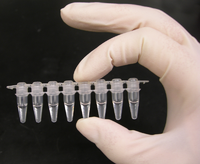
Photo from wikipedia
Nested polymerase chain reaction (PCR) is used in situations in which it is necessary to increase the sensitivity and/or specificity of PCR, for example, when amplifying a particular member of… Click to show full abstract
Nested polymerase chain reaction (PCR) is used in situations in which it is necessary to increase the sensitivity and/or specificity of PCR, for example, when amplifying a particular member of a polymorphic gene family or when amplifying a cDNA copy of an mRNA present at very low abundance in a clinical specimen containing a heterogeneous population of cell types. Nested PCR usually involves two sequential amplification reactions, each of which uses a different pair of primers. The product of the first amplification reaction is used as the template for the second PCR, which is primed by oligonucleotides that are placed internal to the first primer pair. The use of two pairs of oligonucleotides allows a higher number of cycles to be performed, thereby increasing the sensitivity of the PCR. The improved specificity of the reaction derives from the binding of two separate sets of primers to the same target template. Nested PCR is an efficient method to amplify segments of long templates but requires knowledge of the sequence of the target.
Journal Title: Cold Spring Harbor protocols
Year Published: 2019
Link to full text (if available)
Share on Social Media: Sign Up to like & get
recommendations!